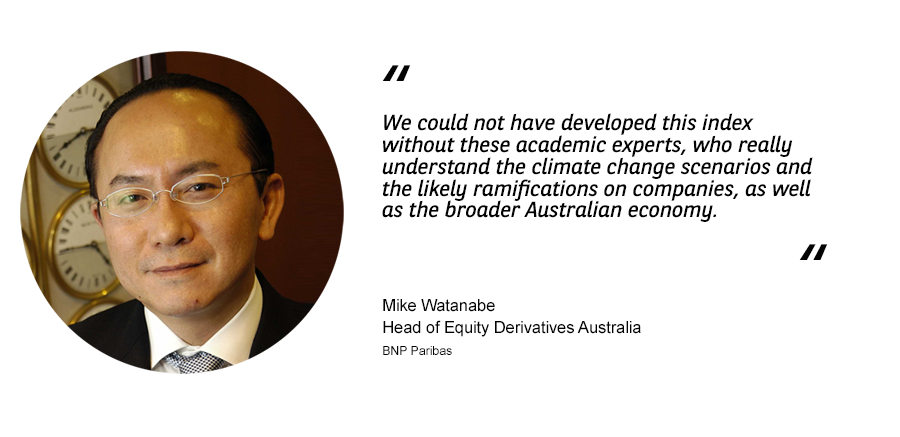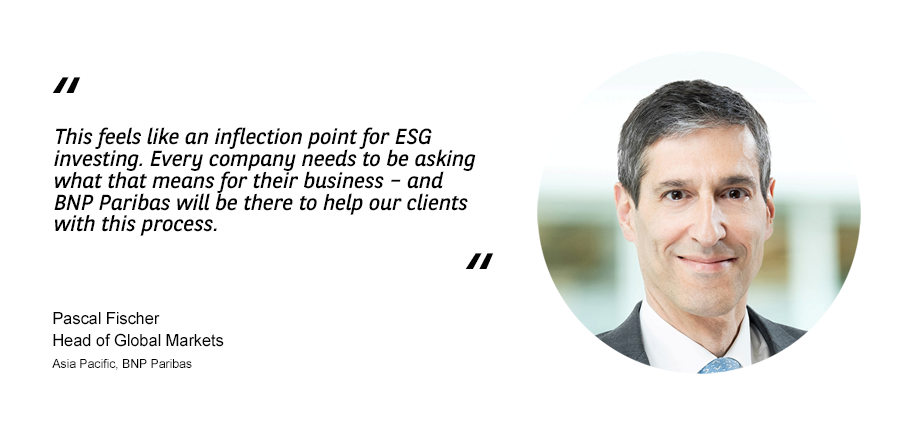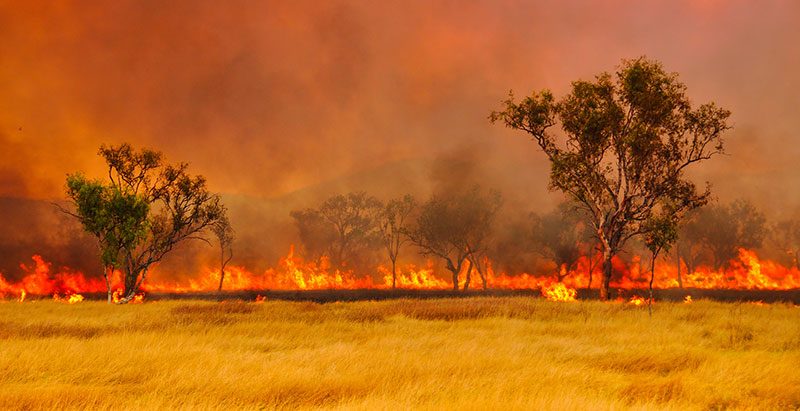The bushfires that swept across Australia in the summer of
2019-2020 horrified people around the world. Thirty-three people and over a
billion mammals, birds and reptiles died as an estimated 17 million hectares
burned.
Bushfires in
Australia are seasonal but, for many, the unusual ferocity of these blazes led
to questions about whether climate change was already impacting Australia.
According to a group of scientists from the World Weather Attribution
consortium, global warming had in fact increased the risk of such severe fires
by about a third. Ominously, it also projected that conditions for fires like
last summer’s would be four times as likely if global temperatures rose by 2ºC over 1900 levels. Not surprisingly, public concern about climate change increased as the
fires raged: one poll in January found that 79 percent of Australians were concerned about
climate change, up five percent from July 2019.
Green and gold
As awareness of the risks posed by global warming grows, more Australians are focused on whether the money they put aside for retirement or to protect themselves against risks is going to companies that are taking action to help limit global warming. That means that more Australian superannuation funds and insurers are integrating climate considerations into their investment decision-making process – and that the companies that are seen to be performing best on climate should therefore have an advantage in attracting capital.Reflecting this trend, three institutional investors – Clean Energy Finance Corporation, First State Super and QBE Insurance – have just subscribed to a series of green bonds linked to the performance of the new BNP Paribas Australian Climate Transition (ACT) Index.
Developed by BNP Paribas in collaboration with ClimateWorks Australia, ISS ESG and The Centre for Quantitative Finance and Investment Strategies at Monash University, this forward-looking index identifies 100 of the top 300 Australian listed companies likely to perform best in scenarios where the increase in global temperatures is kept well below 2ºC over pre-industrial times.
It is the first index in Australia to draw upon dynamic climate scenario modelling, developed by ClimateWorks Australia and the CSIRO and it aims to fill a gap in sustainable finance solutions, helping investors to align their portfolios with their ESG ambitions.
ACT Index Overview 
Stock selection process incorporates:
|
The ACT Index is the product of years of collaboration with the academic experts, beginning with BNP Paribas’ tie-up with Monash University’s CQFIS that began in 2017. The mission of the Centre is to develop and disseminate research studies and practice guidance on quantitative finance and investment strategies. It has been supported by BNP Paribas including the provision of their internal market data for research work.
Mike Watanabe, Head of Equity Derivatives Australia at BNP Paribas is the driving force behind what is named “Project Green Kangaroo”, working hand in hand with its partners in a rare, but exciting, collaboration between the private and public sectors.

“We could not have developed this index without these academic experts, who really understand the climate change scenarios and the likely ramifications on companies, as well as the broader Australian economy,” says Watanabe. “Similarly, we were able to bring our expertise in financial index creation to help develop this investable product.”
ClimateWorks Australia CEO, Anna Skarbek, agrees the collaborative effort was mutually beneficial. Her organisation has spent years researching in detail the implications of climate transition in the Australian context, leading to the development of what it calls “dynamic climate scenarios”.
“In our scoring framework, we then ask, is the company exposed to climate transition risks or opportunities, either through its value chain or because of the way it operates? And does the company have a strategy in place to mitigate risks and cease opportunities?” says Skarbek.
From the investor perspective, being able to utilise the index methodology is core to their portfolio-risk mitigation strategy. Until now, there has not been a product available in Australia that affords major investors and asset owners such capability.
This transaction shows the powerful effect of bringing investors, philanthropy and financial institutions together to fight climate change.
“BNP Paribas Global Markets is committed to pioneering new and
innovative capital markets products to help clients align investment aims and
sustainability goals,” said Delphine Queniart, Global Head of Sustainable
Finance & Solutions, Global Markets, BNP Paribas. “This transaction
demonstrates that commitment clearly and shows the powerful effect of bringing
investors, philanthropy and financial institutions together to fight climate
change.”
Under the terms of
the equity-linked bonds, the investors’ capital is protected and their returns
will be linked to the positive performance of the ACT Index.
Wall of money
Australia’s nearly $2 trillion superannuation fund industry isn’t alone in seeking to back companies that are supporting the transition to a lower-carbon economy. The 521 asset owners – such as pension funds and sovereign wealth funds – that have signed up to the United Nations’ Principles for Responsible Investment have collective assets under management of $23.5 trillion. Including asset managers as well, the signatories’ AUM rises to $103 trillion, up from $20 trillion in 2010.This momentum for investing in accordance with Environmental, Social and Governance (ESG) principles is reflected by inflows into funds, too. A record $15 billion was channelled into sustainable exchange-traded funds during the first six months of 2020. And BlackRock, the world’s biggest asset manager, said in July that sustainable ETFs in its iShares suite had gathered $11 billion so far in 2020, more than double the inflows for the whole of 2019.
For companies, the shift of capital towards ESG investment strategies comes at the same time as global regulators join the drive to meet the targets of the Paris Agreement. The Australian Securities Exchange (ASX) already encourages listed companies to consider whether they have material exposure to climate change risk by referencing the recommendations of the Task Force on Climate-related Financial Disclosure (TCFD) and, if they do, to make the disclosures the TCFD proposes, which are widely regarded as the gold standard for climate-related reporting.
Long and short of it
Globally, institutional investors are also turning to alternative investment strategies to back companies with strong sustainability credentials. BNP Paribas Asset Management’s new Environmental Absolute Return Thematic (EARTH) Fund is a global equity hedge fund that will take long positions in companies that are addressing climate and environmental challenges and pair those investments with short positions in less sustainable firms, including those whose business models are vulnerable to transition risk.During a year of unprecedented market volatility, compelling reasons are emerging to back companies with strong ESG performance. According to research released by Morningstar in June, close to 60 percent of European sustainable funds delivered better returns than similar conventional funds over the last 10 years. This resilience was highlighted as markets were roiled by the global spread of Covid-19 in the first four months of the year: BlackRock said 88 percent of sustainable indices outperformed market benchmarks during this time. It’s a similar story in Australia, where the Responsible Investment Association Australasia found that superannuation funds pursuing responsible investment strategies across their entire fund have outperformed peers over one, three and five year time horizons.
Momentum shift
As sustainable investment strategies becomes more popular – and evidence of their outperformance grows – more Australian and global companies will find it in their interests to embrace ESG disclosure and take action on climate change, experts say.
Those that move earlier should enjoy an advantage as this trend continues to gather momentum. The RIAA said that just 14 of the 57 superannuation funds it surveyed in 2019 had articulated and demonstrated comprehensive responsible investment approaches across its framework – but that it sees more “supers” embracing ESG because of its growing acceptance as an investment strategy, heightened consumer awareness and regulatory focus.
“More than ever before, listed companies owe it to their shareholders to put ESG at the heart of their strategy,” said Pascal Fischer, Head of Global Markets Asia Pacific at BNP Paribas. “This feels like an inflection point for ESG investing. Every company needs to be asking what that means for their business – and BNP Paribas will be there to help our clients with this process.”
